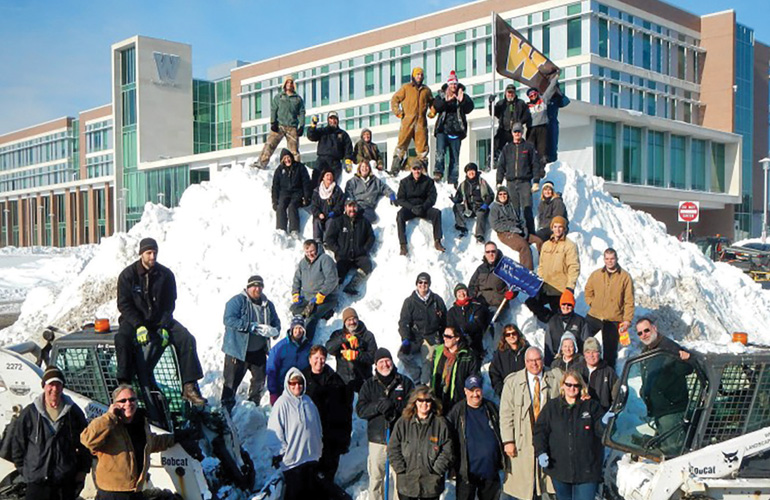At the 1,200-acre Western Michigan University campus in Kalamazoo, MI, a significant task for the Landscape Services team, a unit of the WMU Facilities Management, is to maintain safe and accessible routes for students and staff. With a relatively long snow season, the team created an annual snow removal plan for campus, called the “Snow Book.”

Here is an overview of the snow removal plan as created by Landscape Services, a unit of the Facilities Management department at Western Michigan University (WMU). The “Snow Book” can be accessed here.
The websites states: “The annual snow removal plan or Snow Book is a detailed description of the protocol and process by which Landscape Services keeps campus safe and open during the long Michigan winters. The success of the snow book can be seen every winter when the WMU campus is open and accessible in time for staff and students to get to their campus destination.” [The 2018-19 Snow Book can be viewed online.]
According to the website: “Work on the Snow Book starts soon after the previous winter ends, by evaluating and adjusting plans to the changes in campus schedules and facilities.
With all the new construction, staff, equipment, venues and events, the snow book must be modified to provide our customers with the safest campus experience even during the worst weather. This publication is a collaborative effort combining extensive information from administration, dining, residence life, entertainment venues, athletics, custodial and maintenance, and requires many hours of effort from many staff to complete. The detailed maps that make up this publication are updated annually and require the skilled work of our GIS staff and students.”
The 2018-19 Snow Book is an 88-page document.
The 2018-19 Snow Book outlines the snow removal plan, including the order in which surfaces on campus are addressed.
“First there are streets (20-plus lanes miles): Campus streets have continual coverage for snow removal. Contracted heavy equipment operators are scheduled to accommodate 24-hour coverage, seven days a week, throughout the snow season. Coverage of the streets is prioritized, with ring roads given first priority and all interior roads next, thus opening the heavily trafficked roads first.”
“Another significant space type is the parking lot (100-plus acres): Covered by the same contracted staff and equipment as the streets, lots are divided into five priorities: faculty-staff parking lots; primary visitor lots; dining service loading docks and courts; student commuter lots; and campus apartments and residence hall lots.”
“The third type of space to attend to is walks and steps (39 miles of walk; 200,000 square feet of step, ramp and entry surfaces): The campus is divided into three regions for purposes of sidewalk snow removal, as well as for landscape maintenance throughout the year. During the snow season, seven employees work in these regions operating light equipment, i.e., 4×4 with front plow and sander, skid loaders, and tractors.”
The WMU website in this section notes that: These light equipment operators work weekdays… There is additional coverage during weekday afternoons, as well as during day-shift hours on weekends. The remainder of the regional crews is responsible for clearing access ramps, steps and other areas that are inaccessible for light equipment. They work Monday through Friday.
“Priority is given to access ramps and entries. Weekend and evening snow removal of ramps, steps and walks inaccessible to light equipment is covered for emergency; on excessive conditions, additional staff are called in on an overtime basis.”
Other important aspects of the snow removal plan at WMU, as included in the 2018-19 Snow Book are as follows:
“Landscape Services understands the special needs of students with disabilities and the difficulty of maneuvering over snow and ice. Effort is made to contact all disabled students, faculty, and staff to accommodate their needs.”
“Meanwhile, emergency road and parking lot snow and ice removal is a collaborative effort by WMU Landscape Services and the Department of Public Safety.”
WMU Landscape Services notes on this website that it has “again contracted with a weather forecasting service to give us specific data on our area in Kalamazoo, Michigan. We also have direct weather information access through a satellite link into the Landscape Services office at WMU’s Physical Plant on East Campus. We believe that this will give us an additional edge to fight the snow and ice that the weather conditions bring us.”
In addition to the snow removal outline information featured here, the WMU Landscape Services Snow Book includes campus maps, list of parking and walking areas to be addressed, and relevant information for students and staff.
To learn more about the WMU Facilities Management-Landscape unit, visit the Western Michigan University website.
Do you have a comment? Share your thoughts in the Comments section below or send an e-mail to the Editor at acosgrove@groupc.com.











![[VIDEO] Dickies®: Discover Workwear That’s Anything But Uniform](https://turfmagazine.com/wp-content/uploads/2023/06/1647663814-4b1a2a7742790a9b1e97a3b963477850192e1d6a9dfba9b07214a77bae25d6e3-d-218x150.jpg)






























![[VIDEO] Dickies®: Discover Workwear That’s Anything But Uniform](https://turfmagazine.com/wp-content/uploads/2023/06/1647663814-4b1a2a7742790a9b1e97a3b963477850192e1d6a9dfba9b07214a77bae25d6e3-d-324x160.jpg)